Quick search
CTRL+K
Quick search
CTRL+K

Hamburg, with more than two million inhabitants, is Germany’s second largest city and the absolute metropolis of northern Germany. Its wealth has been created over the centuries as a successful member of the Hanseatic League, where Hamburg grew large as a port city, and to this day the maritime element is a continuing source of trade and tourism.
Hamburg is one of Central Europe’s great gates to the world. The trade has gone through the city for centuries, which now has lovely business districts, markets and lots of sights. Life around the harbor has been greatly developed in recent years, with the historic warehouses of Speicherstart being transformed into activities, offices and with housing and cultural institutions blended beautifully into the old settings.
The cultural life is also very exciting with a varied selection of, for example, museums, parks and outdoor life. Then of course you can also take a walk through the colorful district of St. Pauli. The theater scene is interesting with big and small venues.
The center of Hamburg also offers ample opportunity to look at churches and other beautiful buildings. The Kontorhausviertel district, with many distinctive 20th-century buildings, is an example of special architectural monuments. German engineering is also present with the Alter Elbtunnel, which crosses the Elbe in an unconventional way.
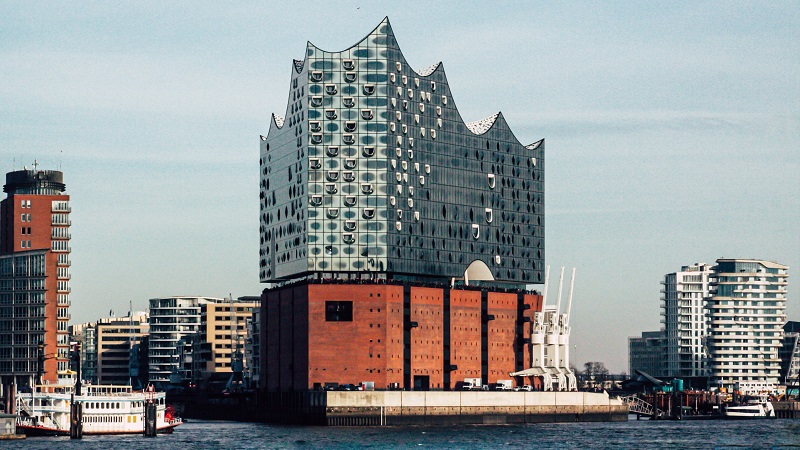
Among the district Speicherstadt’s many warehouses is the large Kaiserspeicher facing the river Elbe and the city’s main harbor. Kaiserspeicher is named after Emperor Wilhelm I and was first built in 1875 according to Johannes Dalmann’s drawings. The warehouse had a tower facing the Elbe and became a sight known to all the townspeople. During World War II, the warehouse was destroyed, and in 1963 what remained of it was blown up and a new version of the Kaiserspeicher was built.
On top of the concrete warehouse building from 1963 is one of the landmarks of modern Hamburg, the Elbphilharmonie concert complex, which stands as a majestic landmark for the city. With its splendid location almost in the middle of the Elbe, it connects the maritime history and present of Hamburg with the city’s rich cultural life and experimental architecture. A hotel has also been arranged in part of the building.
With its impressive size and prominent location, Hamburg’s town hall, the Rathaus, is the dominant building in the city center. It was built in sandstone and erected in the period 1886-1897 as the city’s fifth town hall.
The town hall has more than 600 rooms and halls, where the city government’s chambers and offices belong. The large festsal/Festsaal is 46 meters long, 18 meters wide and measures 15 meters to the ceiling. The hall is adorned by five large paintings that depict the city’s history from 800 to 1900. Here also hang city coats of arms from 62 of the members of the Hanseatic League, which included Hamburg among them.
The facade of the town hall building itself is 111 meters wide, and the skyward tower is 112 meters high. The style is a fine mix of Italian and North German Renaissance. In the center of the town hall is an inner courtyard where you can see the Hygieia well/Hygieia-Brunnen, which was made of bronze. Hygieia means health, and the well was erected as a symbol of an overcome cholera epidemic in 1892.
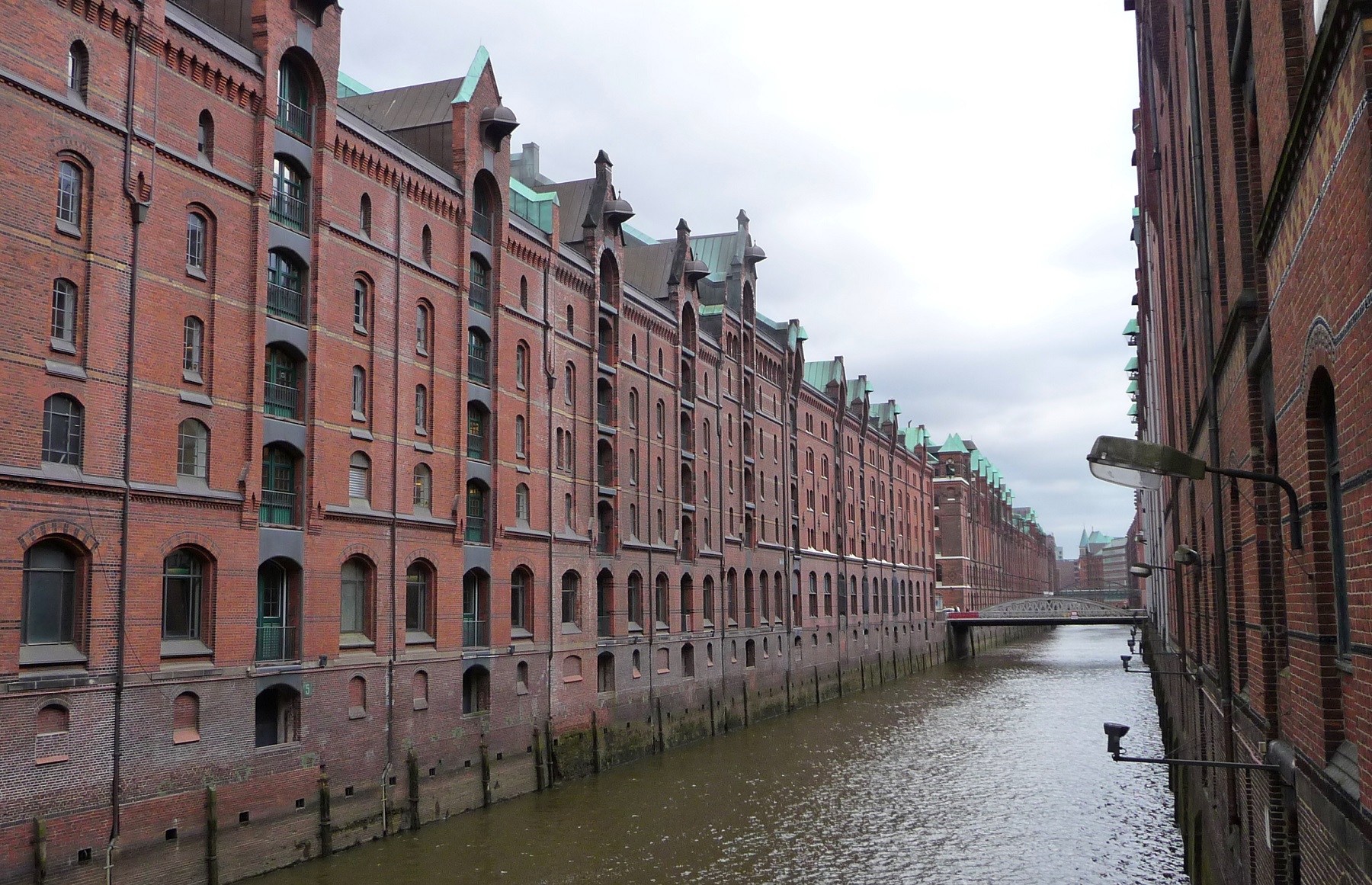
Speicherstadt, whose name refers to the site’s many warehouses, is a district in Hamburg that lies between the old town and part of the city’s huge harbor area. The district was laid out as free harbor areas in the period 1883-1926; it happened as a result of the growth after the city’s admission to the German customs union.
Speicherstadt is approximately 1.5 kilometers long and a few streets wide. Along its length, the area is cut through by canals, which made it possible to sail directly into the many warehouses that are located here.
Today, Speicherstadt has been transformed from harbor areas into a very lively district with cozy environments, several attractions and exciting architecture. The many bridges, canals and neo-Gothic warehouses are an experience which, together with the more modern and coherent neighbor to the south, HafenCity, offers classy architecture and contrasts from recent centuries.
In the district’s former energy center, Kesselhaus (Am Sandtorkai 30), you can take a closer look at the urban development project HafenCity in, among other things, a model of the area.
It is recommendable to simply take a walk here to smell the atmosphere and possibly visit some of the district’s museums. The modern buildings are located primarily in HafenCity and the western end of Speicherstadt, but also around the central basin (Sandtorhafen). Some constructions strive for the old warehouse style and together with the original buildings create a harmonious and interesting whole.
Miniatur Wunderland is the world’s largest model railway and a paradise for anyone who wants to take a closer look at a miniature world. On the site’s more than 4,000 square metres, there are, among other things, themed landscapes from Scandinavia, the Alps, the USA and Hamburg.
In the various landscapes there are well-known buildings, and more than 800 trains run through it all. In the area with Scandinavia, there are for example local landscapes, the Great Belt Bridge and 30,000 liters of water in the exhibition.
Computers control the facility, where there are hundreds of thousands of miniature people and lamps. They really come into their own when the day ends and Miniatur Wunderland changes to an evening and night atmosphere.
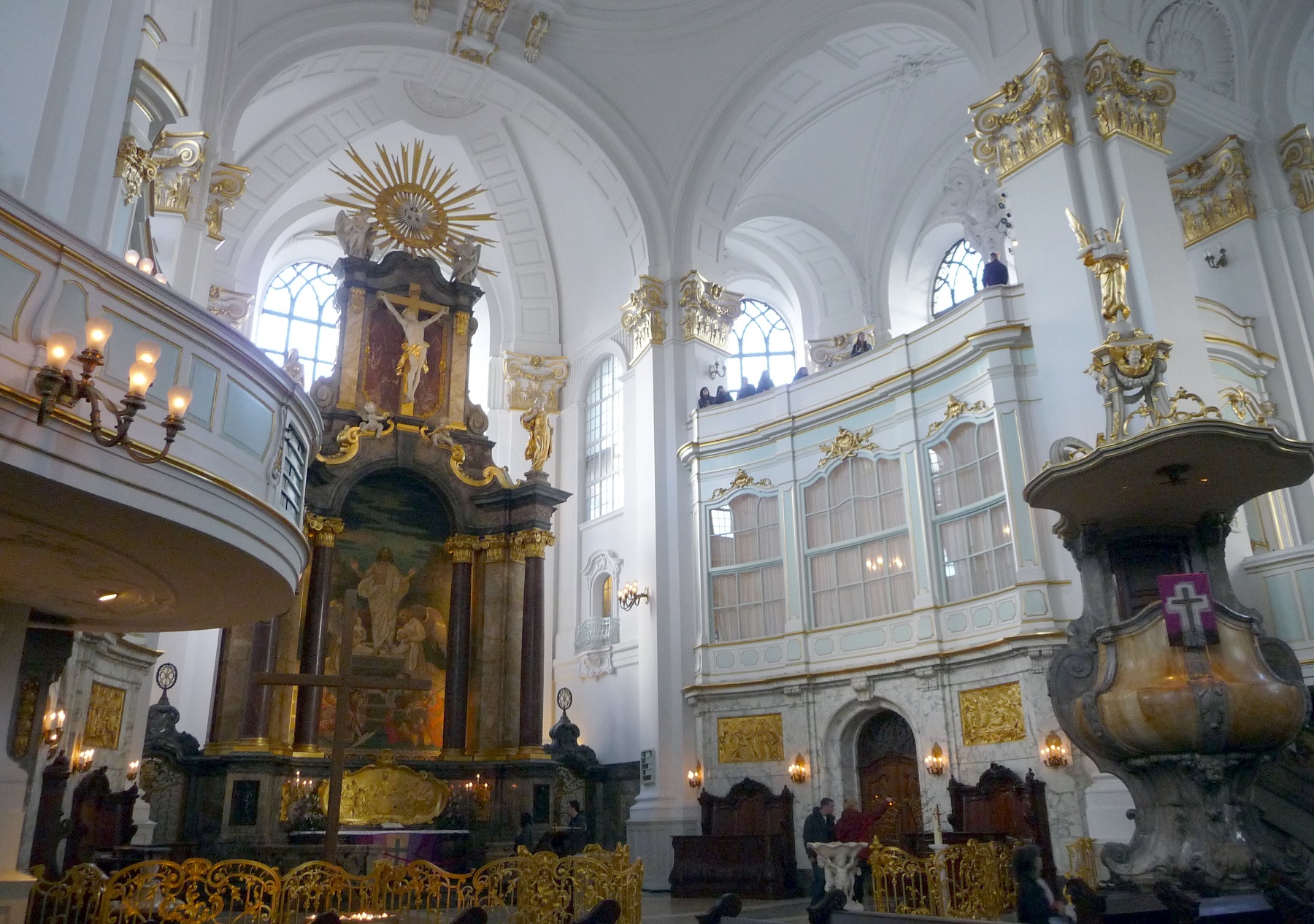
The Church of St. Michaelis is Hamburg’s and Northern Germany’s most important baroque church and at the same time probably Hamburg’s best-known church building and one of the city’s landmarks. The church is named after the archangel Michael, who can be seen as a bronze sculpture at the main entrance. Archangel strikes a pose of victory over Satan.
The current St. Michaelis Kirche was built in the 18th century after a devastating lightning strike on 10 March 1750, when the original 17th century church was destroyed.
The new church was completed in 1786 according to the design of Johann Leonhard Prey and Ernst Georg Sonnin. In 1906, fire again broke out in the church, and as in 1750, both tower and nave burned. Six years later, the church was reconstructed, and despite heavy bombing in the area during World War II, St. Michaelis relatively lightly damaged at the end of the war.
St. Michaelis Kirche is the youngest of Hamburg’s five main churches, and with a capacity of more than 2,500 churchgoers also the largest. The beautiful and bright church space is shaped like a cross, and architecturally you are met with incredible lightness everywhere you look.
The 132 meter high church tower is Hamburg’s second tallest and has served as a sea mark for sailors on the Elbe over the centuries. At a height of 106 metres, there is a viewing balcony from which there is a fine view over the city.
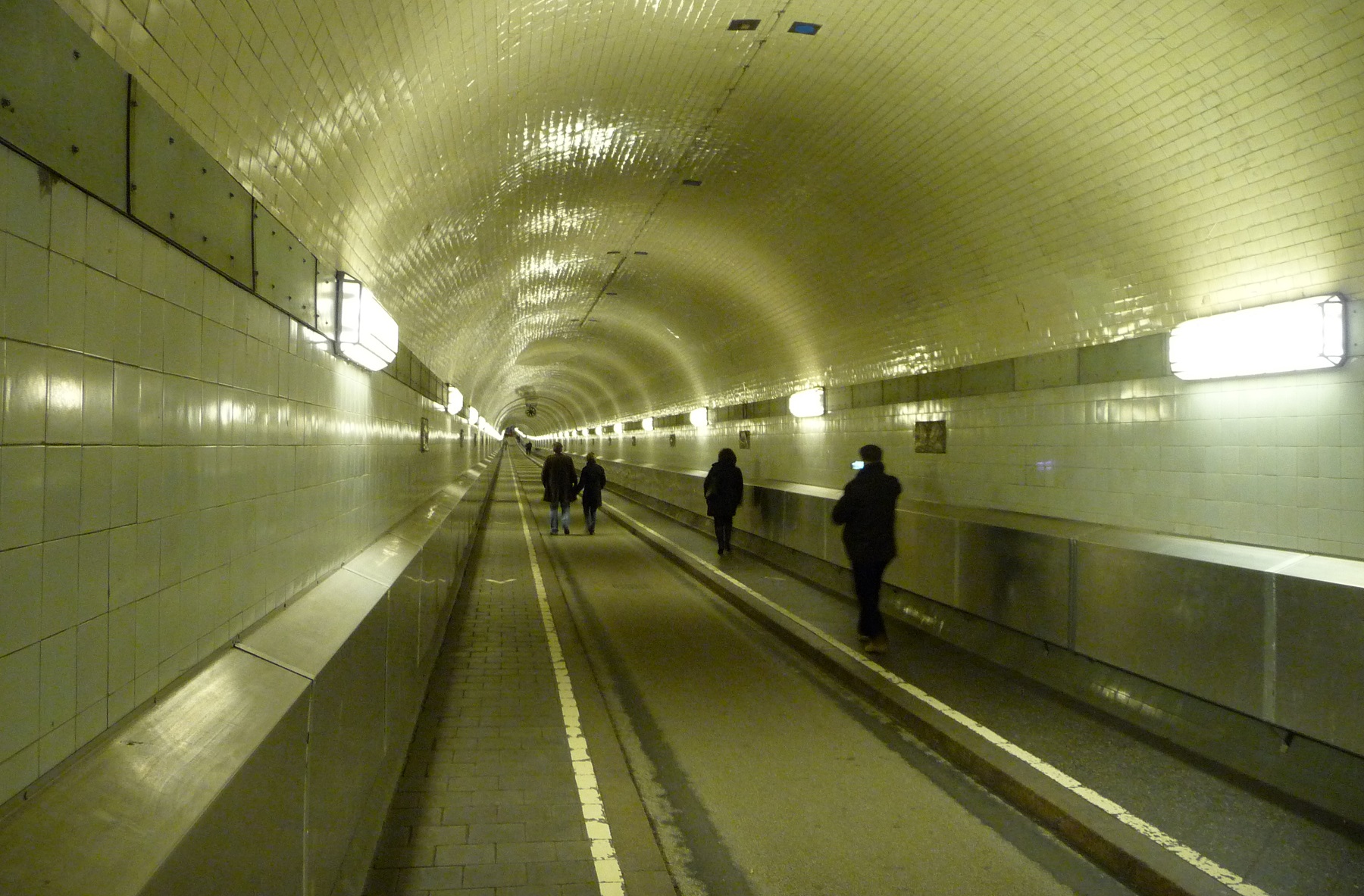
Alter Elbtunnel is one of Hamburg’s more distinctive sights. The square building with the dome at the harbor houses the engineering company from 1911, the old tunnel under the Elbe. After four years of construction, the tunnel was opened under the name St. Pauli-Elbe tunnel, and it could save workers to the port and shipyards on the south side of the Elbe from the entire 12 kilometers of land transport.
At both ends of the tunnel, there are four large elevators that lower cars and people 24 meters down, where the 426 meter long tunnel tubes cross the river. The modest traffic at the time compared to today and the location without space for long ramps were conditions that pointed to elevator shafts as a good solution, and to this day the tunnel is a quick shortcut under the river.
You can take the car for a ride through the Alter Elbtunnel, and you can also choose to go down instead of taking the elevators and go all the way under the Elbe on foot. To the south you come up to Steinwerder’s harbor area.
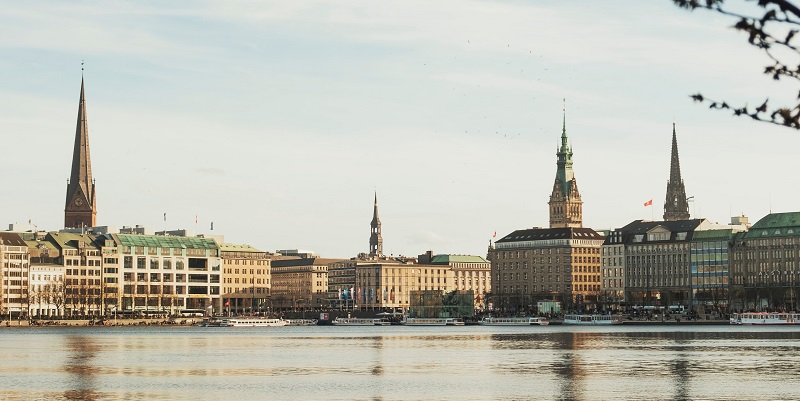
Jungfernstieg is one of Hamburg’s elegant shopping streets, and at the same time a frequently used promenade down to the Binnenalster lake. It is on Jungfernstieg that the famous department store Alsterhaus is located (Jungfernstieg 16-20), and along the lake there are lovely atmospheric places with outdoor seating.
Along the Jungfernstieg, in addition to the Alsterhaus, you can see a number of large buildings, including banks and hotels. They underline the street’s prominence, and Jungfernstieg was paved as early as 1838 as the first street in Germany.
From Jungfernstieg, the many tour and route boats sail out on the two Alster lakes. The southernmost is the Binnenalster with the large fountain in the middle, and north of the bridges Lombardsbrücke and Kenndybrücke lies the Außenalster, which extends to the suburbs of Hamburg. The classic trip on the lakes takes one hour, and you can also take several trips of two hours, which also sail along Hamburg’s canals.
St. Petri Church was originally built from the 12th century, and with its dedication in 1195, it is Hamburg’s oldest parish church. Church construction continued over several centuries, and the 132 meter high tower was completed in 1516. It is built on the highest point in the old town and is, for example, 5.5 meters higher than the nearby square in front of the town hall.
The great fire in 1842 destroyed St. Petri Church, so only a few walls remained. As early as 1849, the church was rebuilt according to the neo-Gothic designs of Alexis de Châteauneuf and Hermann Felsenfeldt. However, the tower was not completed until 1878.
You can get quite high up in the church tower, from which there is an excellent view of the city in all directions. On the way up, you come to various viewing platforms, before finally reaching a height of 123 meters after a total of 544 steps.
You can also enjoy various works of art in the church, including a painting from 1460 that shows Bishop Absalon from Bremen, who is also called the Apostle of the North for his efforts to Christianize Scandinavia.
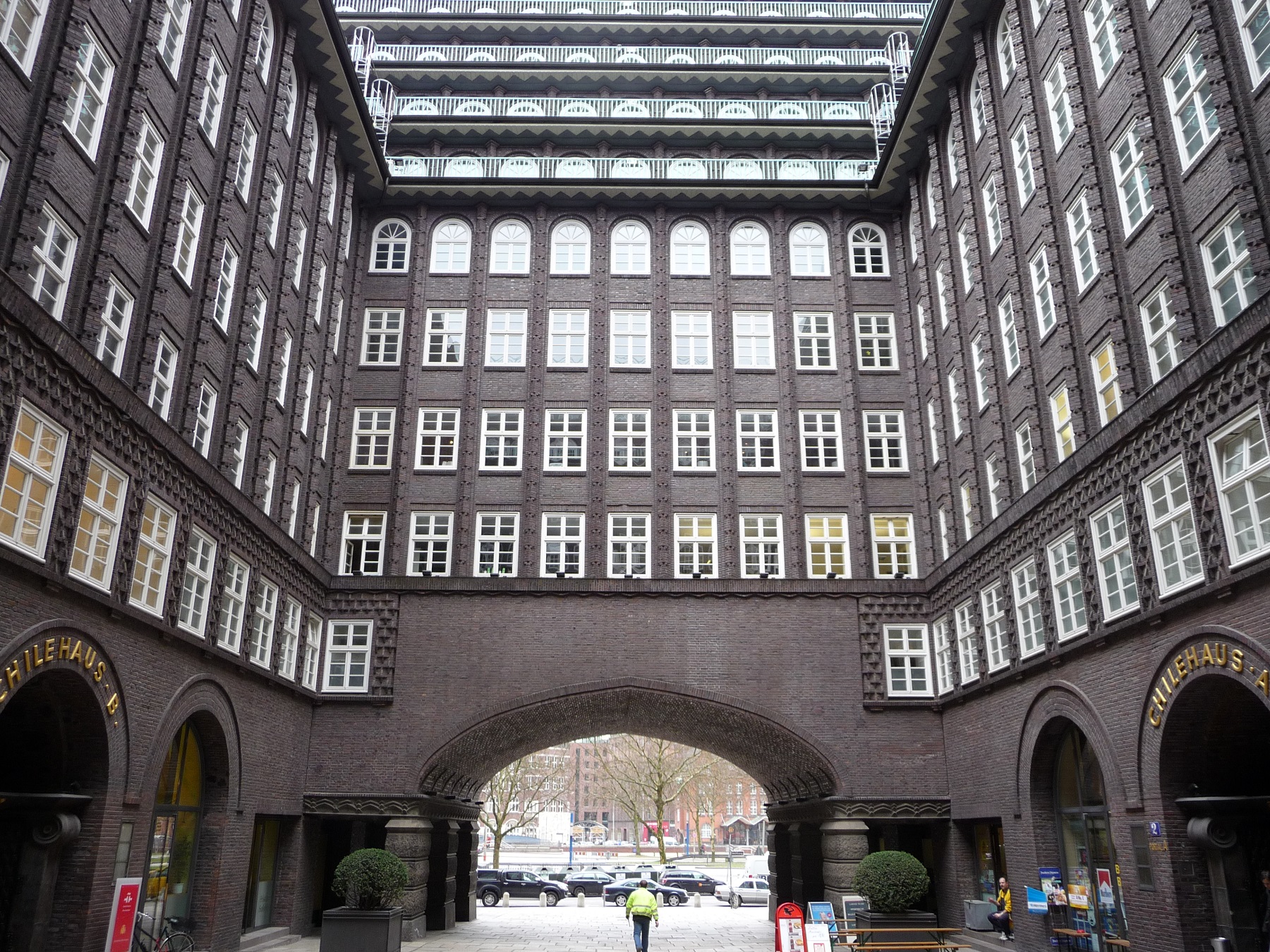
Kontorhausviertel is a district in Hamburg’s old town. It is located between the streets Steinstraße, Meßberg, Klosterwall and Brandstwiete and was built on a newly redeveloped area, which until the end of the 19th century still had a medieval street network and miserable conditions for the residents. After a cholera epidemic in 1892, the sanitation was adopted.
In the Kontorhausviertel there are a few houses from around 1900, but the district is best known for the large office buildings that sprang up in the 1920s and 1930s. The first of these houses was the Miramarhaus (Schopenstehl/ Kattrepel), which was built in 1921-1922. Of other interest is the Montanhof (Niedernstraße/Kattrepel) on the corner opposite the Miramarhaus. It dates from 1924-1926 and features Art Deco elements.
North of this is the Pressehaus (Speersort) from 1938. It was built for the newspaper Hamburger Tageblatt and has been home to several publishers over the years.
To the northeast of the district and all the way to Altstädter Straße are three large buildings; Altstädter Hof (Altstädter Twiete) from 1936-1937, Sprinkenhof (Springeltwiete) from 1927-1943 and Bartholomayhaus (Altstädter Straße) with the large gables from 1938-1939.
To the south you will find probably the district’s best-known building, Chilehaus (Fischertwiete), and Meßberghof (Meßberg), both built in the years 1922-1924.
The Mönckebergstraße pedestrian street is Hamburg’s well-known business district with lots of shops, eateries and department stores. Depending on the season, there are also different markets here, and not least the large Christmas market is a pleasure to visit. The Christmas market extends to the square in front of the city’s town hall, the Rathausmarkt.
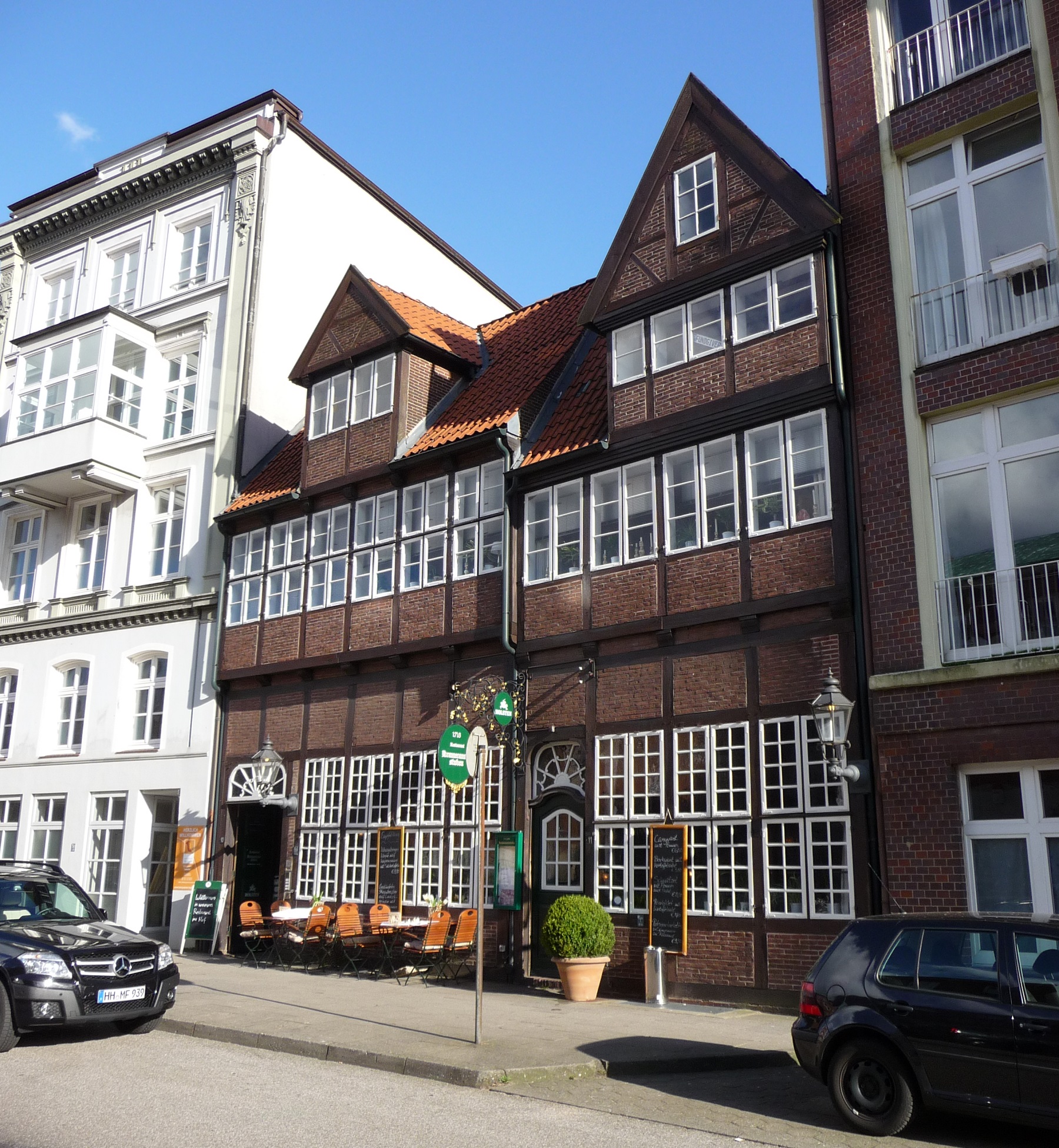
The idyllic Krameramtswohnungen buildings were built in the 17th century to house the families of small traders. The building is typical of the Hamburg of the time, but today it is the only preserved one of its kind. A museum has been set up in one of the homes, where you get an impression of daily life in 17th-century Hamburg.
The Internationales Maritimes Museum is a maritime museum housed in Hamburg’s oldest preserved warehouse. On the many floors, thousands of years of maritime history are told through countless ship models, effects, photographs, documents and so on.
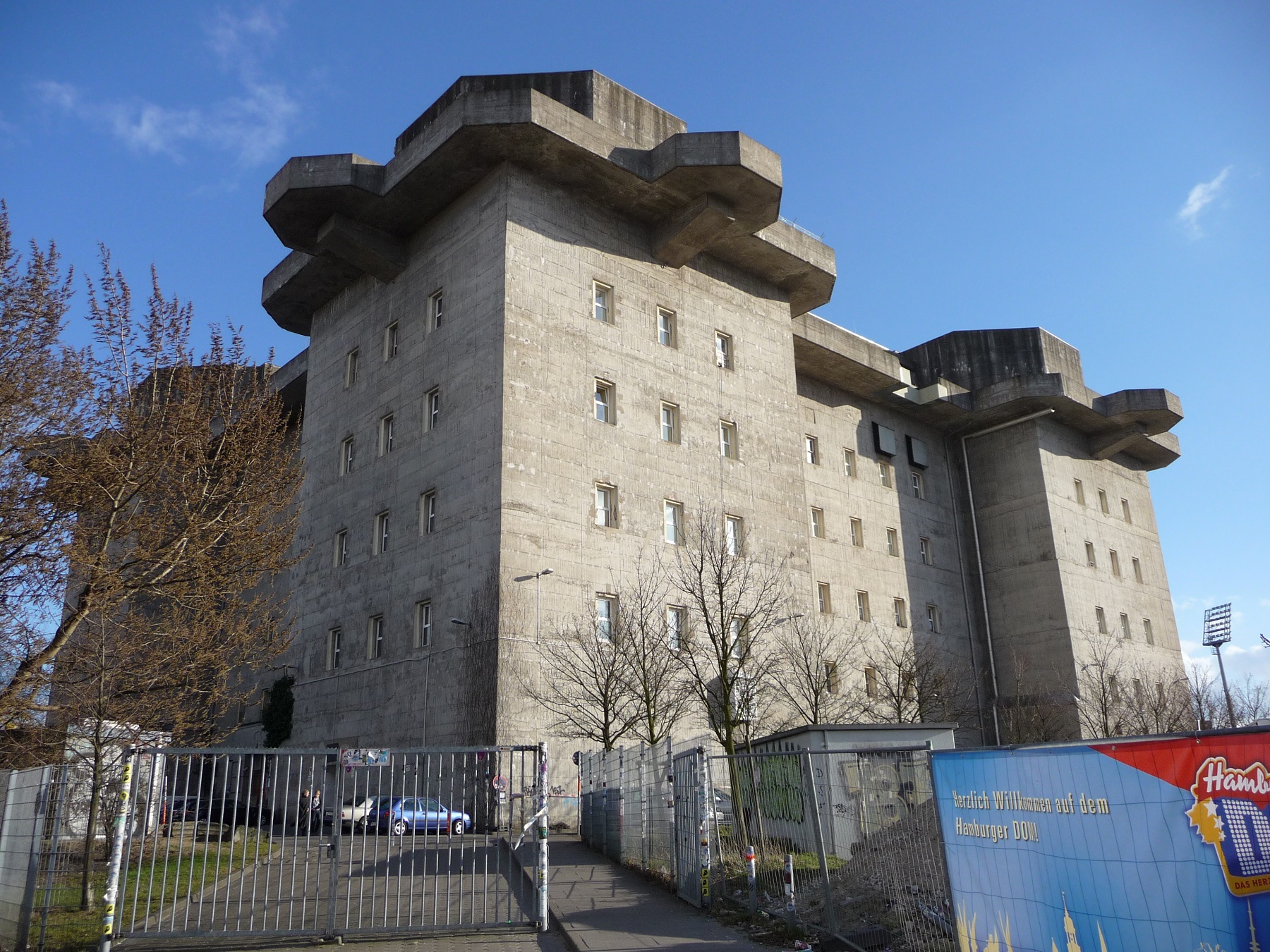
Flakturm IV is one of two flak towers that were built in Hamburg during World War II. The flak towers were erected all around the German territory as part protection and part as a platform for air defense against the Allied invaders.
The first flak turrets were ordered to be built in Berlin in 1940, while similar orders were made for Hamburg and Vienna in 1942. Hamburg was a bombing target not least because of the city’s shipyards, which built part of Germany’s submarines.
Flakturm IV was built through the so-called Organization Todt, which was a civil and military engineering unit. The number IV was given after the start of construction, and it was thus the fourth started in Germany. The flak tower had a floor plan of 71×71 meters and a height of one of the largest bunkers ever built.
There was officially room for 18,000 people in the bunker, which has 3.5 meter thick walls and a 5 meter thick roof. During air raids, several more than 18,000 sought refuge here.
After the end of World War II, the tower was used for civilian purposes. It was considered to blow it away, but in addition to valuable square meters inside, people were nervous about the effect of the explosive charge on other buildings in the area.
The other flak tower in Hamburg is Flakturm VI, which still stands south of the Elbe in the district of Wilhelmsburg (Neuhöfer Straße). A third tower east of the city center was also planned, but this remained on the drawing board.
Hamburg’s city museum is very interesting with its detailed exhibitions about the city’s history. The development of the city itself from its foundation to today is described and told. You can see many important objects from several centuries and get a good insight into the lives of the citizens over time.
A particularly interesting depiction is the history of Hamburg’s port, which has been decisive for Hamburg’s development and which continues to be a colossal asset for the globally minded trading city. The harbor is exhibited, among other things, in pictures, models and texts.

Planten un Blomen is a park of 47 hectares, which for the most part is laid out on the ramparts north-west of Hamburg that were looped in the 19th century. The name Planten un Blomen is Low German and simply means Plants and Flowers.
The first plant in the park was a plane tree, which was planted by the German botanist Johann Georg Christian Lehmann in 1821, and since then many different areas have been established here. You can, for example, enjoy a rose garden, Japanese garden plants, water features, greenhouses from the old botanical garden and also preserved parts of the historic ramparts and moats.
In Hamburg’s busy and growing port, in 1839 the first quays were established in the current St. Pauli Landungsbrücken. Back then, the site was on the outer edge of the harbour, and for a number of years there was a terminal for steamships, and many passengers have traveled on overseas lines from here.
Floating pontoons connected to the mainland by a series of bridges came into being in the early 1900s, and the characteristic terminal buildings in volcanic tuff were erected 1907-1909. The tower, Pegelturm, serves as a landmark for St. Pauli Landungsbrücken, and in it, in addition to a clock, there is also a water level gauge that indicates the status of the Elbe’s tides. You can see this in a window facing the Elbe.
Today, there is a leben in the area, from where you can, among other things, go on a harbor cruise or on a trip to the island of Heligoland in the North Sea. A number of cafes, restaurants and shops can also be found here.
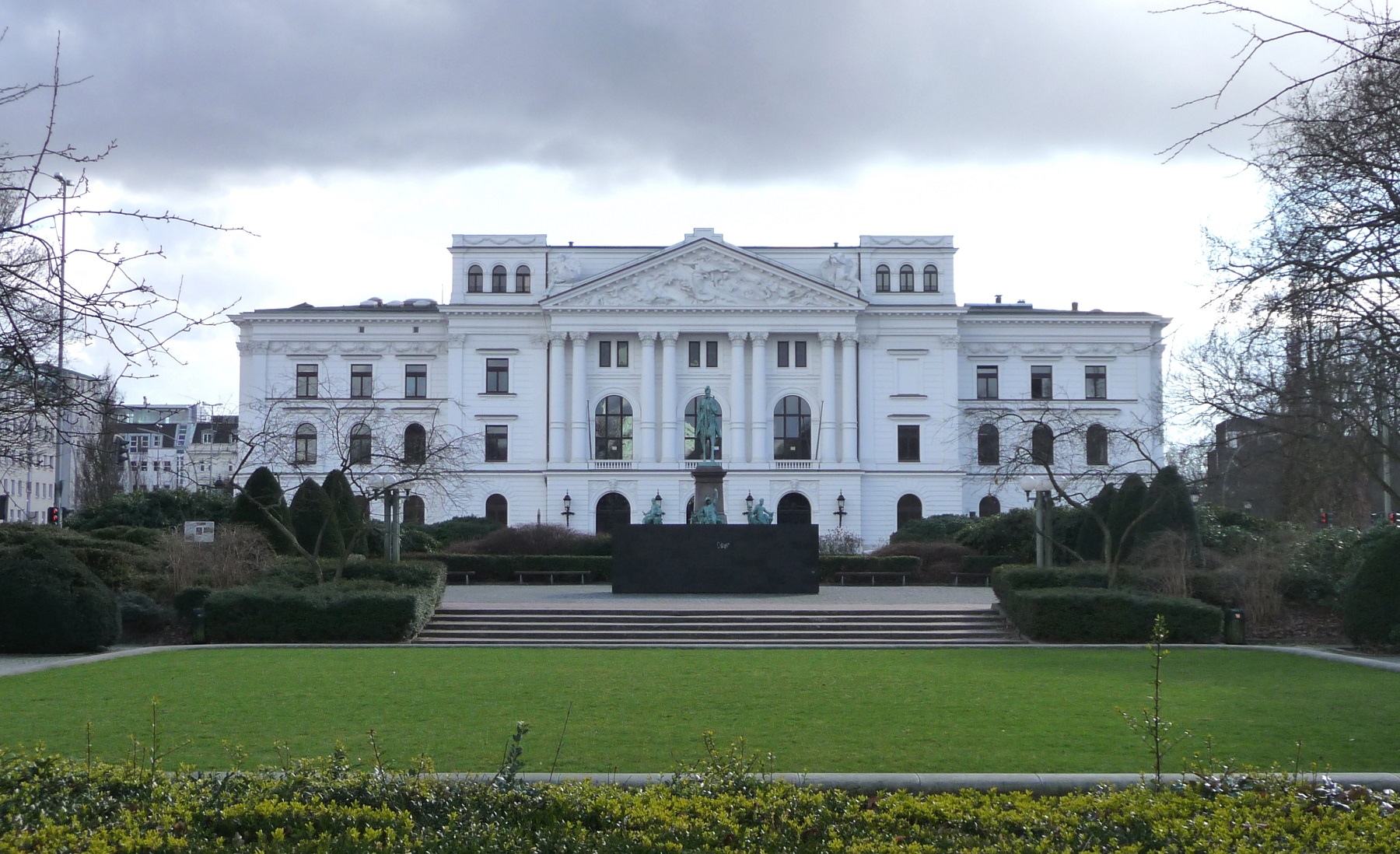
Altona is today a suburb to the west of the center of Hamburg, but until 1 April 1938 it was an independent city; then in Holstein. However, the city’s history goes back several hundred years.
Altona was founded in 1535; initially as a fishing village. Already in 1664, King Frederik III gave the town its freedom certificate, which meant freedom from customs, which led to good opportunities to develop a trade. Until 1864, Altona, like the rest of Holstein, belonged to Denmark.
However, Altona was, among other things, the starting point for the first railway in the Danish Empire, the Altona-Kiel line, which opened in 1844. This southern part of the Danish Empire was thus modernly connected to the region’s capital Kiel and from there on to the capital Copenhagen.
During the Second World War, Altona’s old town was largely destroyed, and this not least went beyond the central areas towards Hamburg and the Elbe. Reconstruction and new growth marked the post-war period, and despite the short distance to the metropolis to the east, there is still a fine and independent atmosphere in Altona today.

Heligoland is a small rocky island located in the North Sea northwest of the city of Cuxhaven. Heligoland has an exciting history, fantastic nature, and the island actually consists of both Heligoland and the neighboring island of Düne. The main island consists almost of two independent parts, one part of which is a sandstone cliff of up to 61 meters in height with steep slopes, while the other part is flat lowland. The two parts are called Oberland and Unterland.
Heligoland belonged to Denmark until 1807, when England during the Napoleonic Wars conquered it and subsequently took over its governance. The island became German in 1890, and Germany then established a naval base on Heligoland. On 18 April 1945, the British bombed Heligoland, which British troops occupied after the end of the war. In 1947, the British blew up all the island’s military installations in a gigantic explosion that changed Heligoland’s appearance. In 1952, Germany got back the island.
Glückstadt is a town located on the Elbe and was also founded by the Danish king Christian IV in 1617 precisely to become a competitor to Hamburg further down the river. The city was called Lykstad and was fortified and equipped with advantageous trading privileges and religious freedom to attract inhabitants. In the 17th century, trade with Iceland and Greenland was established from here, among other things. Lykstad also became a certain source of income for the king and Denmark, as Christian IV introduced the Elbe toll, which had to be paid by every passing ship.
Today, just over 10,000 inhabitants live in Glückstadt, where there are many experiences for visitors. The center of the city is the Markedspladsen/Markt, from which the streets radiate in all directions within the historic center that lay behind the fortresses. On the market is the city’s town hall from 1642-1643, which was built in the late Dutch Renaissance, and here is also the 53 meter high City Church/Stadtkirche, built 1618-1623. At the church you can see a bust of the town’s founder, King Christian IV.
Around the harbor there is a good maritime atmosphere and some nice gabled houses to the north along the street Am Hafen. Here you will also find the Palace of Contemporary Art/Palais für aktuelle Kunst (Am Hafen 46), which was built in the Renaissance 1630-1631 and altered in Baroque style in 1697. In the period 1700-1752, the palace was the government chancellery. Today, you can see changing art exhibitions here.
In addition to this, you can see several mansions such as Brockdorff Palæ/Brockdorff-Palais (Am Fleth 48), which was built in 1631-1632 by Count Christian Pentz, who was fortress governor in Lykstad and thereby the town’s most powerful man. Today, the mansion is a museum, where you can take a closer look at King Christian IV, the city’s history and many other historical events such as the Thirty Years’ War through documents, effects etc.
Another mansion is Wasmer Palæ/Wasmer-Palais (Königstraße 36), which was built in several stages by conference councilors Conrad von Wasmer and Jacob Johann von Wasmer in the years 1700-1728. In 1752, it was taken over by Denmark’s King Frederik V and made the seat of the government office in the city. An apartment was also set up in the mansion, where members of the Danish royal house could be accommodated during their stay in the city.
On 31 October 1807, the mansion entered history when Denmark declared war on England from here. The declaration came in response to the British terrorist bombing of the Danish capital during the Copenhagen Bombardment and fell on the day Denmark entered into an alliance with French Napoleon. Today, the Wasmer-Palais is set up as the Glückstadt Musikskole/Musikschule Glückstadt.
The town of Itzehoe, with just over 30,000 inhabitants, is the oldest in Holstein, which is part of the state of Schleswig-Holstein. Its history goes back to 809, when Count Egbert had a fortress built as a defense of the Frankish kingdom against the Danes from the north. The city was given city rights by Adolf IV in 1238, and over time it has been destroyed and rebuilt several times; among others by the Swedes during the Thirty Years’ War in the 17th century.
In the years 1835-1864, Itzehoe was the seat of the Holstein Estates Assembly; a status that ended with Denmark’s rule. Like the rest of Holstein, Itzehoe also belonged to the Danish Empire until 1864, when, after a few years of administration by Austria, it was incorporated into Prussia in 1867.
Itzehoe’s old town lies like an oval north of the river Stör and centered around the Market Square/Markt. Both here and in other parts of the city centre, the city’s historical importance is shown in many distinguished buildings.
Among the sights are the baroque Sankt Laurentius City Church/Stadtkirche St. Laurentii (Kirchenstraße 6), which was built 1716-1718. In the former noble mansion, Prinzeßhof (Kirchenstraße 20), there is now a local history museum for the circle.
The Old Town Hall/Altes Rathaus and the seat of the Holstein Ständerforsamling Sæde/Sitz der Holsteinischen Ständeversammlung as well as a number of town houses are located on the Market Square/Markt.
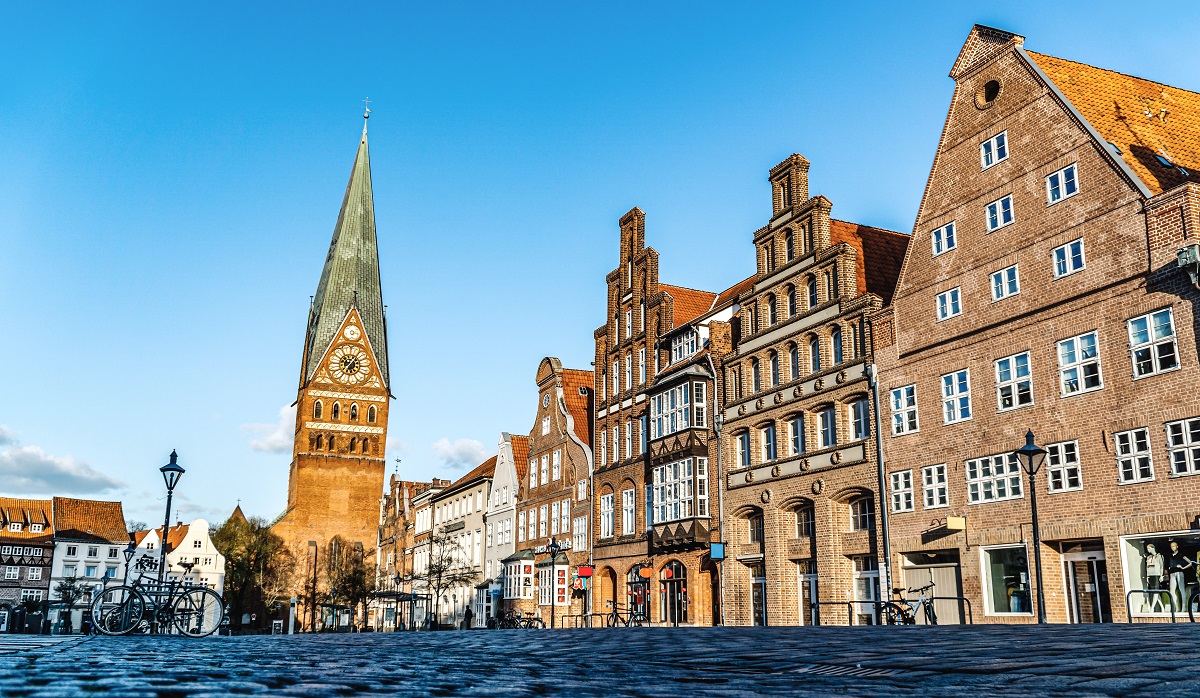
The city of Lüneburg is an old city that has become rich from the area’s large salt deposits. The exploitation of the salt began more than 1000 years ago, and the historical richness can be seen in the streetscape’s many fine buildings that have been built from the Middle Ages to the present day. Lüneburg was thus a prosperous member of the Hanseatic League.
Today, the city has just over 60,000 inhabitants and offers a range of experiences. Museums include the Lüneburg Brewery Museum/Brauereimuseum Lüneburg (Heiligengeiststraße 39) and the German Salt Museum/Deutsches Salzmuseum (Sülfmeisterstraße 1). The pleasant effect of salt on the body can be experienced in the spa area Salü Salztherme (Uelzener Straße 1-5).
Lüneburg Town Hall/Lüneburger Rathaus (Am Markt) is one of Germany’s largest and most beautiful medieval town halls. Construction has been going on for 500 years. The earliest parts date from the 13th century, and the baroque facade was not completed until 1720. The impressive halls from the 15th century are some of the absolute highlights. The town hall is located on the Markt square, where there are a number of other beautiful houses. You can also take a walk in the cozy streets that lead out from here, e.g. Große Bäckerstraße, where you can see a number of beautiful gabled houses.
Gabled houses can also be found on the square Am Sande, which is the medieval center of Lüneburg. With the elegant buildings, the square is a particularly fine example of the result of the economic ability the city has possessed over time.
In Lüneburg’s central district there are also three large, old churches. Saint John’s Church/St. Johannis Kirche (Bei der Sankt Johanniskirche) is the oldest of the churches, built in the period 1289-1372, but later remodeled and expanded. Saint Michael’s Church/St. Michaelis Kirche (Johann-Sebastian-Bach-Platz) was built from 1376 until the tower was completed in 1434. Sankt Nikolaj Church/St. Nikolai Kirche (Lünerstraße) was built in the period 1407-1440 as the youngest of the three large churches. The 92 meter high church tower was built in its current form during the 19th century.
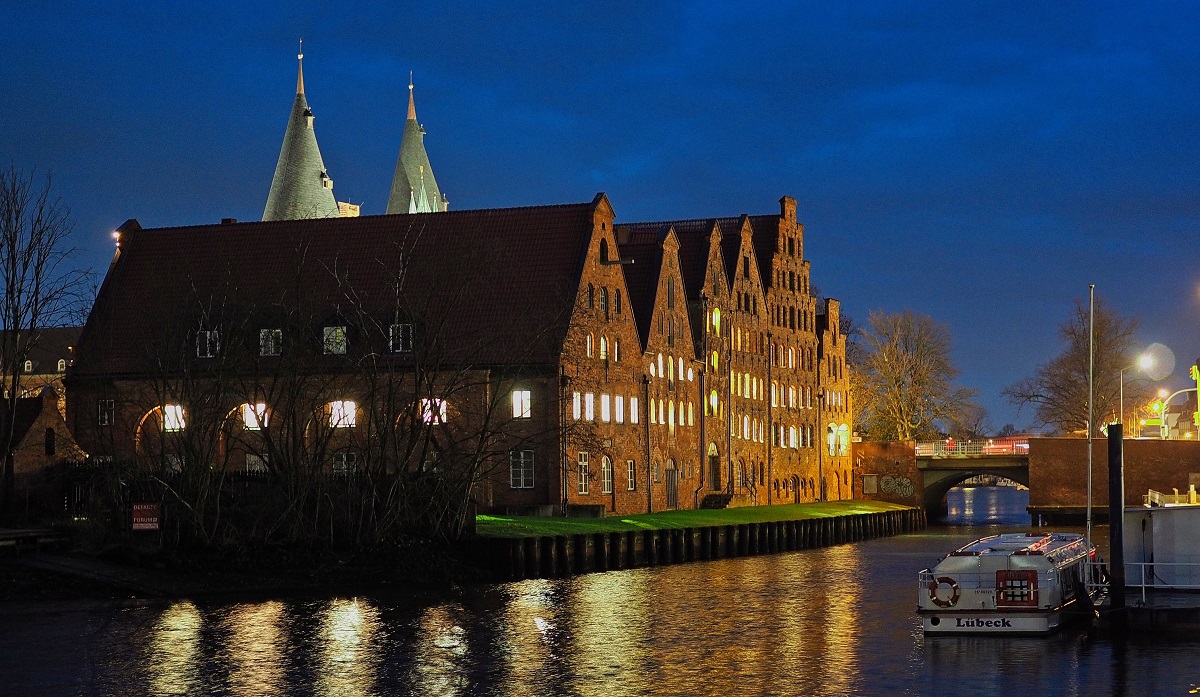
Lübeck was the queen of the Baltic Sea Region’s Hanseatic cities. It still is, and that is not without reason. Majestic churches and countless houses, monasteries and other medieval buildings stand as evidence of the immense wealth that came to the city over the centuries with trade routes.
The old town of Lübeck is located on an island in the Trave River, which provides a natural boundary for this part of the city where everything is within walking distance. In addition, the river and its banks are like a blue-green belt around the city, which can be enjoyed in many places, for example on a river boat, where you sail the Trave around the center of Lübeck.
Jungfernstieg 16-20
alsterhaus.de
Mönckebergstraße 3
galeria-kaufhof.de
Hamburger Straße 27
hamburger-meile.com
Mönckebergstraße 16
karstadt.de
Hannoversche Strasse 86
phoenix-center-harburg.de
Große Elbstraße 68
stilwerk.de
Mönckebergstraße, Jungfernstieg, Große Bleichen, Neuer Wall, Karolinenviertel, Schanzenviertel
Hamburg Dungeon
Kehrwieder 2
Hamburg Zoo, Tierpark Hagenbeck
Lokstedter Grenzstraße 2
hagenbeck.de
HSV Museum
Sylvesterallee 7
hsv.de
KL!CK Kindermuseum
Achtern Born 127
kindermuseum-hamburg.de
Miniature Wunderland
Kehrwieder 2, Block D
miniatur-wunderland.de
Planetarium
Hindenburgstraße 1
planetarium-hamburg.de
Prototype
Shanghaiallee 7
prototype-hamburg.de
U-434
Versmannstraße 23c
u-434.de
The history Hamburg begins with the construction of the castle of Hammaburg at the beginning of the 8th century in the area between the river Elbe and the lake Alsteren. The castle was ordered built in the year 808 by Emperor Karl the Great in defense of Vikings from the north and slaves from the east.
The castle was destroyed and rebuilt many times over the following centuries, including the ravaged Vikings under the Danish King Erik area and destroyed in 845 the city, which at that time had about 500 inhabitants. Again in 880 Hammaburg was ravaged; this time by both Danes and slaves.
In 831, Hammaburg became the home of Ansgar, the Apostle of the North, who was ordained an archbishop. In 847, the Archdiocese’s seat was merged with Bremen, and it was from here that he went to Scandinavia and Christianized the Vikings; in Denmark immediately to the north.
With the Archbishop’s seat in 831, Hamburg also gained a cathedral; Saint Mary’s. Here the pope Benedict V was not approved by the emperor in 966. The church ended up being demolished in the years 1804-1807, and the only remembrance today is the street name Domstraße, which occupies the location of the historic church.
With increasing trade, however, Hamburg’s role quickly shifted from defense and church bastion to a market town, and with important Lübeck’s founding on the Baltic, Hamburg became the natural port with access to the North Sea.
In 1189, Hamburg was officially modeled on city rights under Lübeck, thereby establishing it as a city. The initiative came from a number of merchants, and shortly afterwards Emperor Frederick I Barbarossa gave Hamburg a number of privileges as a sanctuary in the empire, including duty and trade rights. The privileges were granted following Hamburg’s support for the emperor’s crusade.
Duke Valdemar, the later Danish king Valdemar II, overcame Count Adolf of Rendsburg, and this later escaped from prison by surrendering all land north of the Elbe. The German-Roman emperor demanded the land in 1214, and Hamburg was under Danish control.
The Danish era lasted only until 1227, when the battle of Bornhøved in Holsten on July 22 became decisive for Holsten, Mecklenburg and Pomerania to switch to German counts from the Danish crown. Before then, the Danish government had gathered Hamburg as a city under a set of laws and governed from one place.
From 1230 new, larger defenses were established around Hamburg, which, like many other cities in the Middle Ages, had city walls and gates in a ring around it. These plants are still visible today in Hamburg’s cityscape, such as the park Planten un Blomen, which has just been built on the old fortress areas.
In 1264, the city senate passed a law that imposed severe penalties for practicing violence against, killing or eating swans. This somewhat special law was due to a belief that Hamburg would remain a sanctuary as long as there were swans in the Alster. A number of other laws regulated various other more or less curious conditions in the thriving city.
In 1241, over the following centuries, the successful Hanseatic League was established through two agreements between Hamburg and Lübeck. One agreement meant that the cities would defend their freedom and rights together, while the other meant securing the road between the two cities.
With these agreements, the Hanseatic League’s cities, and thus Hamburg’s importance and economy grew. The important trade was invested in, and the paving of the central east-west street of the city was just the third in Northern Europe to receive this paving; and it was named Steinstraße, which you can still find in the city center.
Hamburg, in 1266, entered into an agreement with the English King Henry III, which allowed the city’s merchants to set up a Hanseatic office in London, thereby manifesting the city’s overseas perspectives.
The field was introduced as currency in 1377 by the Vendish Coin League, founded by the cities of Hamburg, Lübeck, Lüneburg, Rostock and Wismar.
By this time Hamburg had grown to 14,000 inhabitants and was thus the third largest city in the Hanseatic League. Only Cologne and Lübeck were larger.
In 1410 Hamburg got its first constitution, and with the wave of reform in the 16th century a Protestant state church was formed in Hamburg. The city senate had asked Martin Luther to send his colleague Johannes Bugenhagen, who established the new church.
Over the centuries, Hamburg’s economic life flourished, and as the Hanseatic League’s power and dominance diminished, Hamburg continued to grow steadily, establishing its own economic infrastructure. The city’s stock exchange opened in 1558 and Hamburg Bank in 1619.
A number of Dutch merchants also flocked to the city after a period of religious persecution in their home country – it further substantiated Hamburg’s position. The city also established its own military to protect the city’s merchant fleet.
At the end of the 17th century and until 1768 there was fierce competition between Hamburg and the Danish Altona for trade and shipping. The conflict ended with a political agreement in 1768, after which Hamburg gained new growth potential.
Napoleon incorporated Hamburg in France in 1810, and it had a temporary impact on development. The city was exposed to a mainland barrier that made much of the trade difficult, partly taken over by the neighboring town of Altona (which is now part of Hamburg). It belonged to the Danish Empire and was thus subject to other conditions.
After Napoleon’s fall in 1815, Hamburg became part of the new German federation, and in 1819 the city was established as its own state, “The Free Hanseatic City of Hamburg”. Soon after, the city regained its commercial base and thus its thriving economy, a situation that was further improved with all the new possible trade routes and partners in Africa, America and Asia.
On May 4, 1842, marked itself significantly in the history of Hamburg. In the street Deichstraße started a fire that quickly spread to large parts of the city. The fire was first extinguished on May 8, and it caused a setback for Hamburg. The great fire destroyed up to a third of the city; among others, the town hall and most of the city’s large churches went up in smoke.
Although Hamburg was quickly rebuilt, it was a costly affair, but here too the city rebuilt despite the fact that tens of thousands had become homeless and many institutions and churches needed to be rebuilt.
In the latter half of the 19th century, Hamburg’s growth boomed. The population reached over 800,000 and had thus quadrupled in a few decades. It was not least the large and rapidly growing traffic across the Atlantic that made Hamburg one of Europe’s largest port cities with all that belonged to it.
The port was continuously expanded and a new part was put into service. Speicherstadt, which today is an exciting new and alternative activity and residential district, grew with many large warehouses and trading companies for the constantly increasing international sea trade. The city was growing, and industrialization was also characterized by, for example, a number of shipyards. The city was Germany’s second largest after the capital Berlin.
Hamburg had, in the early centuries of growth, bought land by the Elbe in order to expand its trading capacity. In 1938, the city itself was expanded by including not least Altona and Harburg in Hamburg itself.
The 20th century was also marked by the two world wars, where Hamburg, with its many large yards and high industrial production, was the target of allied bombings. Both the bombs themselves and the subsequent fires destroyed much of the city center. The vast port areas were almost completely destroyed, as did some of the city’s extensive industrial facilities.
The subsequent rebuilding of Hamburg went strongly in the following years, and it created new economic growth for the city, which happened to be large parts of West Germany.
Today, Hamburg remains its own federal state in the Republic as “The Free Hanseatic City of Hamburg”. Hamburg’s inhabitants are wealthy, and the city’s port is the dominant one in Germany and among Europe’s largest. The city is rich in educational places and the cultural scene is very active. The population is very international and this makes the city one of Germany’s windows to the world.
Major development projects along the harbor put new Hamburg on the world map, where the entire warehouse district Speicherstadt, the new development HafenCity and the exodus Museum BallinStadt lead to tourists and citizens favor new experiences. The crown of the work in the middle of the Elbe of the city’s new landmark, Elbphilharmonie, which rises on top of a now former warehouse.
 Hamburg, Germany[/caption]
Hamburg, Germany[/caption]
Overview of Hamburg
Hamburg, with more than two million inhabitants, is Germany’s second largest city and the absolute metropolis of northern Germany. Its wealth has been created over the centuries as a successful member of the Hanseatic League, where Hamburg grew large as a port city, and to this day the maritime element is a continuing source of trade and tourism.
Hamburg is one of Central Europe’s great gates to the world. The trade has gone through the city for centuries, which now has lovely business districts, markets and lots of sights. Life around the harbor has been greatly developed in recent years, with the historic warehouses of Speicherstart being transformed into activities, offices and with housing and cultural institutions blended beautifully into the old settings.
The cultural life is also very exciting with a varied selection of, for example, museums, parks and outdoor life. Then of course you can also take a walk through the colorful district of St. Pauli. The theater scene is interesting with big and small venues.
About the Whitehorse travel guide
Contents: Tours in the city + tours in the surrounding area
Published: Released soon
Author: Stig Albeck
Publisher: Vamados.com
Language: English
About the travel guide
The Whitehorse travel guide gives you an overview of the sights and activities of the Canadian city. Read about top sights and other sights, and get a tour guide with tour suggestions and detailed descriptions of all the city’s most important churches, monuments, mansions, museums, etc.
Whitehorse is waiting for you, and at vamados.com you can also find cheap flights and great deals on hotels for your trip. You just select your travel dates and then you get flight and accommodation suggestions in and around the city.
Read more about Whitehorse and Canada
Canada Travel Guide: https://vamados.com/canada
City tourism: https://visitwhite-horse.ca
Main Page: https://www.vamados.com/
Buy the travel guide
Click the “Add to Cart” button to purchase the travel guide. After that you will come to the payment, where you enter the purchase and payment information. Upon payment of the travel guide, you will immediately receive a receipt with a link to download your purchase. You can download the travel guide immediately or use the download link in the email later.
Use the travel guide
When you buy the travel guide to Whitehorse you get the book online so you can have it on your phone, tablet or computer – and of course you can choose to print it. Use the maps and tour suggestions and you will have a good and content-rich journey.


Jungfernstieg is one of Hamburg’s elegant shopping streets, and at the same time a frequently used promenade down to the Binnenalster lake. It is on Jungfernstieg that the famous department store Alsterhaus is located (Jungfernstieg 16-20), and along the lake there are lovely atmospheric places with outdoor seating.
Along the Jungfernstieg, in addition to the Alsterhaus, you can see a number of large buildings, including banks and hotels. They underline the street’s prominence, and Jungfernstieg was paved as early as 1838 as the first street in Germany.
From Jungfernstieg, the many tour and route boats sail out on the two Alster lakes. The southernmost is the Binnenalster with the large fountain in the middle, and north of the bridges Lombardsbrücke and Kenndybrücke lies the Außenalster, which extends to the suburbs of Hamburg. The classic trip on the lakes takes one hour, and you can also take several trips of two hours, which also sail along Hamburg’s canals.
St. Petri Church was originally built from the 12th century, and with its dedication in 1195, it is Hamburg’s oldest parish church. Church construction continued over several centuries, and the 132 meter high tower was completed in 1516. It is built on the highest point in the old town and is, for example, 5.5 meters higher than the nearby square in front of the town hall.
The great fire in 1842 destroyed St. Petri Church, so only a few walls remained. As early as 1849, the church was rebuilt according to the neo-Gothic designs of Alexis de Châteauneuf and Hermann Felsenfeldt. However, the tower was not completed until 1878.
You can get quite high up in the church tower, from which there is an excellent view of the city in all directions. On the way up, you come to various viewing platforms, before finally reaching a height of 123 meters after a total of 544 steps.
You can also enjoy various works of art in the church, including a painting from 1460 that shows Bishop Absalon from Bremen, who is also called the Apostle of the North for his efforts to Christianize Scandinavia.

Kontorhausviertel is a district in Hamburg’s old town. It is located between the streets Steinstraße, Meßberg, Klosterwall and Brandstwiete and was built on a newly redeveloped area, which until the end of the 19th century still had a medieval street network and miserable conditions for the residents. After a cholera epidemic in 1892, the sanitation was adopted.
In the Kontorhausviertel there are a few houses from around 1900, but the district is best known for the large office buildings that sprang up in the 1920s and 1930s. The first of these houses was the Miramarhaus (Schopenstehl/ Kattrepel), which was built in 1921-1922. Of other interest is the Montanhof (Niedernstraße/Kattrepel) on the corner opposite the Miramarhaus. It dates from 1924-1926 and features Art Deco elements.
North of this is the Pressehaus (Speersort) from 1938. It was built for the newspaper Hamburger Tageblatt and has been home to several publishers over the years.
To the northeast of the district and all the way to Altstädter Straße are three large buildings; Altstädter Hof (Altstädter Twiete) from 1936-1937, Sprinkenhof (Springeltwiete) from 1927-1943 and Bartholomayhaus (Altstädter Straße) with the large gables from 1938-1939.
To the south you will find probably the district’s best-known building, Chilehaus (Fischertwiete), and Meßberghof (Meßberg), both built in the years 1922-1924.
The Mönckebergstraße pedestrian street is Hamburg’s well-known business district with lots of shops, eateries and department stores. Depending on the season, there are also different markets here, and not least the large Christmas market is a pleasure to visit. The Christmas market extends to the square in front of the city’s town hall, the Rathausmarkt.

The idyllic Krameramtswohnungen buildings were built in the 17th century to house the families of small traders. The building is typical of the Hamburg of the time, but today it is the only preserved one of its kind. A museum has been set up in one of the homes, where you get an impression of daily life in 17th-century Hamburg.
The Internationales Maritimes Museum is a maritime museum housed in Hamburg’s oldest preserved warehouse. On the many floors, thousands of years of maritime history are told through countless ship models, effects, photographs, documents and so on.

Flakturm IV is one of two flak towers that were built in Hamburg during World War II. The flak towers were erected all around the German territory as part protection and part as a platform for air defense against the Allied invaders.
The first flak turrets were ordered to be built in Berlin in 1940, while similar orders were made for Hamburg and Vienna in 1942. Hamburg was a bombing target not least because of the city’s shipyards, which built part of Germany’s submarines.
Flakturm IV was built through the so-called Organization Todt, which was a civil and military engineering unit. The number IV was given after the start of construction, and it was thus the fourth started in Germany. The flak tower had a floor plan of 71×71 meters and a height of one of the largest bunkers ever built.
There was officially room for 18,000 people in the bunker, which has 3.5 meter thick walls and a 5 meter thick roof. During air raids, several more than 18,000 sought refuge here.
After the end of World War II, the tower was used for civilian purposes. It was considered to blow it away, but in addition to valuable square meters inside, people were nervous about the effect of the explosive charge on other buildings in the area.
The other flak tower in Hamburg is Flakturm VI, which still stands south of the Elbe in the district of Wilhelmsburg (Neuhöfer Straße). A third tower east of the city center was also planned, but this remained on the drawing board.
Hamburg’s city museum is very interesting with its detailed exhibitions about the city’s history. The development of the city itself from its foundation to today is described and told. You can see many important objects from several centuries and get a good insight into the lives of the citizens over time.
A particularly interesting depiction is the history of Hamburg’s port, which has been decisive for Hamburg’s development and which continues to be a colossal asset for the globally minded trading city. The harbor is exhibited, among other things, in pictures, models and texts.

Planten un Blomen is a park of 47 hectares, which for the most part is laid out on the ramparts north-west of Hamburg that were looped in the 19th century. The name Planten un Blomen is Low German and simply means Plants and Flowers.
The first plant in the park was a plane tree, which was planted by the German botanist Johann Georg Christian Lehmann in 1821, and since then many different areas have been established here. You can, for example, enjoy a rose garden, Japanese garden plants, water features, greenhouses from the old botanical garden and also preserved parts of the historic ramparts and moats.
In Hamburg’s busy and growing port, in 1839 the first quays were established in the current St. Pauli Landungsbrücken. Back then, the site was on the outer edge of the harbour, and for a number of years there was a terminal for steamships, and many passengers have traveled on overseas lines from here.
Floating pontoons connected to the mainland by a series of bridges came into being in the early 1900s, and the characteristic terminal buildings in volcanic tuff were erected 1907-1909. The tower, Pegelturm, serves as a landmark for St. Pauli Landungsbrücken, and in it, in addition to a clock, there is also a water level gauge that indicates the status of the Elbe’s tides. You can see this in a window facing the Elbe.
Today, there is a leben in the area, from where you can, among other things, go on a harbor cruise or on a trip to the island of Heligoland in the North Sea. A number of cafes, restaurants and shops can also be found here.

Altona is today a suburb to the west of the center of Hamburg, but until 1 April 1938 it was an independent city; then in Holstein. However, the city’s history goes back several hundred years.
Altona was founded in 1535; initially as a fishing village. Already in 1664, King Frederik III gave the town its freedom certificate, which meant freedom from customs, which led to good opportunities to develop a trade. Until 1864, Altona, like the rest of Holstein, belonged to Denmark.
However, Altona was, among other things, the starting point for the first railway in the Danish Empire, the Altona-Kiel line, which opened in 1844. This southern part of the Danish Empire was thus modernly connected to the region’s capital Kiel and from there on to the capital Copenhagen.
During the Second World War, Altona’s old town was largely destroyed, and this not least went beyond the central areas towards Hamburg and the Elbe. Reconstruction and new growth marked the post-war period, and despite the short distance to the metropolis to the east, there is still a fine and independent atmosphere in Altona today.
Similar to Hamburg Travel Guide
